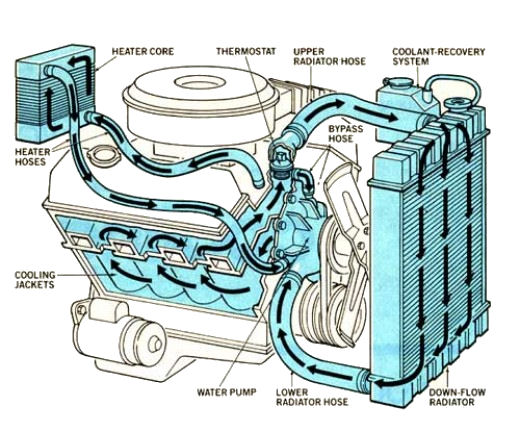How A Cooling System Works

This illustrates a typical big block 396/427/454 cooling system. All small block systems are essentially the same with the exception of the bypass hose. The bypass channel is incorporated into the water pump itself on the driver side and flows into/from the driver side of the engine block.
One 'trick' some people like to do is removing the heater to save weight and running a hose from the outlet fitting (seen here on the intake manifold) to the inlet fitting on the water pump. While this may save a few pounds of weight it reduces the cooling system capacity and leaves you with a defroster; something to think about in a tradeoff. Typically water does not circulate through the heater core unless the heater is turned on. Having this extra capacity can also help cool an engine on hot days by the very nature of more coolant and (if you can stand the heat), you can turn your heater on to circulate more coolant throughout your system and take advantage of the system's coolant capacity.

A thermostat allows the engine to circulate its coolant internally until the designated temperature of the thermostat is reached and allows coolant to flow into the top of the radiator. A thermostat is not designed to cool and engine but rather to allow the engine to come up to operating temperature. Thermostats come in various degrees of operation; 160°, 180° and 192°/195°. This is the temperature the thermostat begins to open.
A small cylinder is located vertically in the center of the thermostat and is filled with a wax that begins to melt at the designated temperature of the thermostat. A plunger connected to a valve presses into this wax as it melts pushing the plunger into the wax and opening the valve to allow water to circulate. When the engine is shut off, or at least cools down below the operating point of the thermostat, the wax begins to solidify and pushes the plunger back up via the spring and closes the valve.
Some people like to drill a couple of 1/8" holes in the valve to allow coolant to circulate into the radiator before the coolant has had a chance to get warm enough to open the thermostat. While this does work in a warm climate where it doesn't take the engine long to produce enough heat to open the thermostat, it might not be such a good idea when weather is cooler. It'll take longer for the engine to warm up thereby taking longer for the thermostat to open and give you heat through your heater or warm enough air to use your defroster.
 Home
Home Decode
Decode Tech
Tech Tools
Tools My Books
My Books Contact
Contact Chevelle
of the Month
Chevelle
of the Month Things
For Sale
Things
For Sale